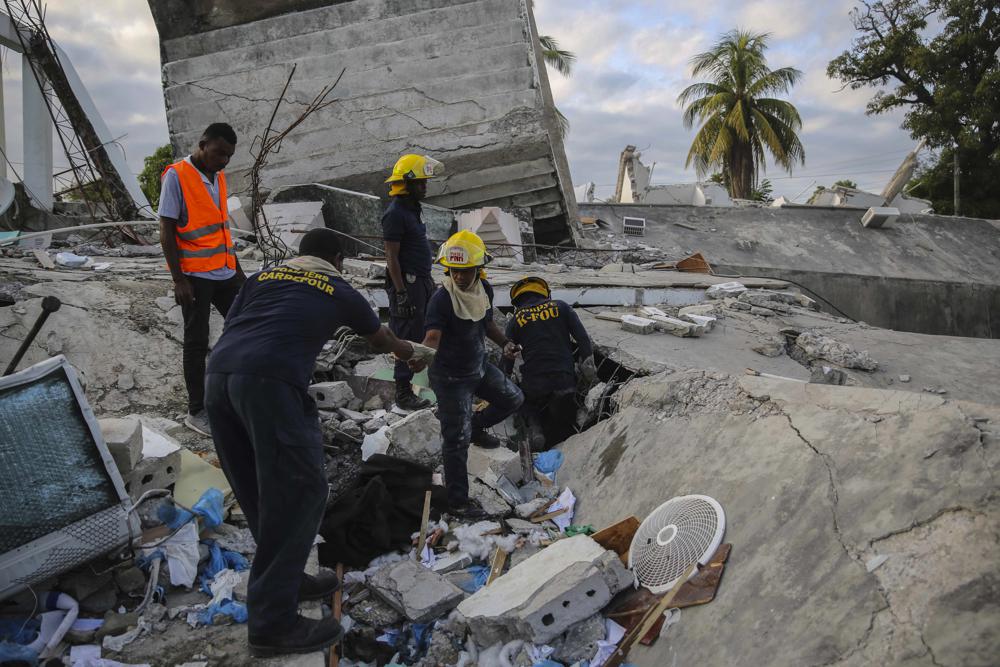
The death toll from a magnitude 7.2 earthquake in Haiti soared to at least 1,297 Sunday as rescuers raced to find survivors amid the rubble ahead of a potential deluge from an approaching tropical storm. Saturday’s earthquake also left at least 2,800 people injured in the Caribbean nation, with thousands more displaced from their destroyed or damaged homes.
Survivors in some areas were forced to shelter in streets or soccer fields with their few salvaged belongings while overloaded hospitals scrambled to help those who were injured.
While we continue to share news and updates coming out of the country, we want to also serve as a place of information and support to organizations that are actively working to provide relief and recovery in Haiti. In 2016, we were part of the first responder’s group in the south, we learned a lot of Do’s and Don’t during that experience, and we’re using that experience to approach how to serve our community. We currently working on sharing a list of organizations and local organizations on the ground we support, how you can support them, and keep you updated on their progress.
In addition, as we galvanize with our teams to help, we want to also share information on some things to consider when supporting relief efforts. Our friends at Hope for Haiti contributed this guest post based on their experience in short- and long-term disaster relief following the devastating earthquake in Haiti in 2010 and Hurricane Matthew in 2016.
Natural disasters and humanitarian crises are recurring issues in many developing countries. Even the United States has been plagued with major hurricanes, tornadoes, and fires in recent years. With each passing year, organizations that serve these areas diligently prepare for the worst and hope for the best. For donors, it can feel overwhelming to research and choose an organization to support in the wake of a crisis. As one of Charity Navigator’s Top 10 Disaster Relief Organizations, Hope For Haiti shared their best advice on how organizations and donors can be good partners during humanitarian disasters.
At its core, a humanitarian response requires quickly developing efficiencies, sharing best practices among organizations/governmental agencies, and learning from past mistakes. At Hope for Haiti, for example, they adjusted their core programmatic approach after the Haiti Earthquake in 2010 based on what they learned during relief efforts. Following Hurricane Matthew in 2016, they applied much of what they learned about logistics, donor communication, and balancing immediate disaster response with long-term recovery.
Here are some things to consider when supporting relief efforts below:
1. First, look to local organizations that are already on the ground.
These organizations are already working in the area and have formed close relationships with the communities they serve and other strategic partners. Their capacity and effectiveness will be greater than an organization that hopes to fly in from a different area and oftentimes lacks a complex understanding of the cultural, political, and logistical context.
2. Pay attention to accountability, transparency, and governance.
As a donor, you want to ensure that the money you’re donating to an organization is going to directly make an impact in aiding relief efforts. Visit Charity Navigator and read up on the organization you’re thinking of donating to. On an organization’s Charity Navigator profile, you’ll be able to access the tools, ratings, and information you need to find a charity that matches your philanthropic criteria. You’ll also be able to see their impact in action through Charity Navigator’s partnership with GuideStar, Classy, Impact Matters, and Global Giving.
3. Support organizations that have short, medium, and long-term plans for disaster response.
Effective disaster response requires sustainability; an organization should address the most pressing issues first, then form plans to address long-term recovery for those affected by the disaster. If an organization can’t outline its plan for aid, look elsewhere.
4. Don’t send things that aren’t needed.
Supplies that may seem to be obviously needed in the wake of a disaster (clothing, water, food) may not actually be the supplies that people need or that organizations are able to distribute. Sending donated items that are not useful, are culturally inappropriate, or undercut local markets could result in what many relief workers call “the secondary disaster.” Check with the organization to learn what is actually needed before starting a supply drive or mailing a box to an organization’s office. For example, you might discover that organizations actually need donations to cover purchasing locally-sold supplies in the disaster area as a way to help the local economy recover.
5. Follow up on how your support was used if you don’t hear back.
All organizations should already be doing this, but if you don’t receive an update after your donation, reach out to find out how your support was used to make a difference. We believe that donors are entitled to see the impact, and organizations should be ready to provide details about how funds were spent and what impact was made. It’s part of the philanthropic journey,
and creates trust, transparency, and a relationship of accountability.
With a little bit of research on the forefront, you can make a marked difference in the lives of people affected by a disaster or humanitarian crisis.





























![Bring the Caribbean to your kitchen.
Discover bold, time‑saving flavor with Épis of Haiti spice blends—perfect for authentic island dishes or a vibrant twist on your favorites. Taste tradition, transform your cooking. [ @episofhaiti ]
Explore the full collection at episofhaiti.com
#AD #lunionsuite #haitianamerican #episofhaiti](https://scontent-lga3-2.cdninstagram.com/v/t51.75761-15/491432320_18506758480023307_6411904492707133407_n.jpg?stp=dst-jpg_e35_tt6&_nc_cat=109&ccb=1-7&_nc_sid=18de74&_nc_ohc=mg9gOnjwWSMQ7kNvwHmwuoi&_nc_oc=AdnLNy2-7vf5do1dbVcTviEujqlBywo5qZEsDvrjqIUKPK8B30RjrhBkQIPsoMb2IJc&_nc_zt=23&_nc_ht=scontent-lga3-2.cdninstagram.com&edm=AM6HXa8EAAAA&_nc_gid=7N_s4NcBekAh1qaaFqmScQ&oh=00_AfGn7mxBpXx_mAYMutd19rGeoTX2P1UJos8xaBSkvNkr6A&oe=6811FC11)
